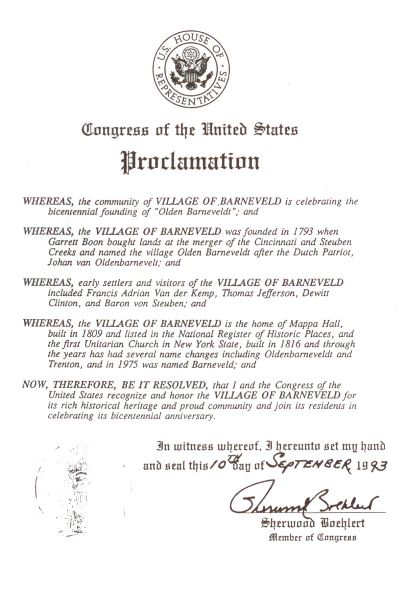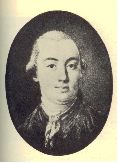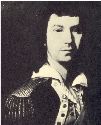The Patriot
by Kees Adema
The Letter
Figure 1 shows a letter dated September 21, 1827 sent from Olden barneveld in New York State1 to S' Hage, The Hague, in the newly created Kingdom of The Netherlands (1815) via Vlissingen (Flushing) in the southwestern province of Zeeland. It had been taken to New York favour of Frank Gebhard Esq., a messenger of opportunity who took the letter to the port of shipment, thereby by-passing the postal service. The notation was later crossed out, probably by the New York forwarder.
Although Dutch independence was restored after the Napoleonic forces had left the northern Netherlands in 1813, postal regulations were still based on the French decrees of 1802 and 1810. Subsequently, in a bureaucratic paper avalanche, the Dutch postal authorities issued numerous decrees, changes in existing regulations or clarifications, one after the other.

Figure 1. Letter dated September 21, 1827, from Oldenbarneveld, New York, to The Hague in the Kingdom of The Netherlands
The first such Dutch regulation is dated February 6, 1816 (circular 72). It increased the existing sea tariff for letters transported by private merchant ships2 from two to eight stivers3, simultaneously doubling the captain's fee to two stivers per letter regardless of its weight. The domestic postage from the port of arrival was added to this. The word Zeebrief (sea letter) had to be written on the back of an incoming letter.
Barely two months later circular 77 ordered a 50% increase in the sea tariff, i.e. to twelve stivers, for a letter weighing less than 1 lood4 (15 grams) while the captain would henceforth receive three stivers for each individual letter. Heavier letters merited a 50% rate increase for each 1/2 lood. In article 35, added to the regulations in July 1817, the postmaster-general added that Zeebrief could now also be handstamped on letters arriving from overseas. The prescribed color was red.
This regulation was further clarified in circular 112 of March 4th, 18185 which states in the part relevant here that:
- postage for letters originating overseas (i.e. including North America) will be based on the same progressive scale, regardless whether they have been franked upon departure;
- the captain will continue to receive three stivers;
- incoming letters need to be marked Zeebrief.
The sea letter rate for a single letter of one lood continued to be twelve stivers.
Following several more clarifications in 1819, the old reference to lood was eliminated in the rate progression and weights were expressed in grams April 4, 1821 (circular 160). Although for the sake of convenience the lood had until now been equated to 15 grams it was officially 16 grams and the basic sea tariff was tied to a letter weighing less than 16 grams. Additional increases of 50% were based on units of eight grams.
On August 22nd 1821 the ports of Flushing (Dutch: Vlissingen) and Den Helder were added to Rotterdam, Amsterdam, Antwerp6 and Ostend6 as ports of arrival. The manuscript Zeebrief was gradually being replaced by a handstamp with the same wording and in Flushing, during 1825, 1826 and 18277 it was used in combination with the VLISSINGEN arrival marking (46 x 5 mm8), one of the many town name stamps issued between 1815 and 1830.
 Figure 2. Handstamps VLISSINGEN (in red) and
Figure 2. Handstamps VLISSINGEN (in red) and
Zeebrief (in red) as applied on the back
From the impressions on the back (Figure 2) it is obvious that these were two separate markings although they were applied at the same time. This combination is only known in red ink.
Finally, effective January 1, 1827, the year this letter was sent, the sea letter rate had to be stated in cents instead of stivers, although increases were based on units of five cents. Therefore in 1827, the ship or sea letter rate from New York to Holland was 60 Dutch cents for a letter weighing less than 16 grams and the hand-written notation on the face correctly reflects this. It was comprised of the sea rate (20 cents) and the Dutch domestic rate (here 25 cents), while the captain received 15 cents.
The History of American Barneveld(t)
I had acquired this letter some years ago, including it in an ever-growing pile of items needing more research. The current day village of Barneveld in New York State had its name shortened from the original Olden Barneveld named in the 1827 letter. While the Dutch village called Barneveld dates to the 12th century, its American namesake was founded in 1793. Initially named Olden (Old) Barneveldt, it was named after the famed Dutch 'Advocate of Holland' Johan van Oldenbarnevelt (1547-1619). Although he was born in nearby Amersfoort the family probably came van (from) Dutch Barneveld originally. Motley's 'The life and death of John of Barneveld'9 (Figure 3) is the definitive study of this statesman's career whose life came to a tragic end when he was beheaded after losing a power struggle with prince Maurice of Orange-Nassau.
 Figure 3. Johan van Oldenbarnevelt
Figure 3. Johan van Oldenbarnevelt
As serendipity would have it our daughter and her family moved to New York State some time ago and a recent visit seemed the perfect opportunity to stop at Barneveld and do some more research into this letter which I had acquired many years ago. Meanwhile I had done some reading to find out more about the writer of my letter, Francis Adrian van der Kemp, about whom more later.
Barneveld's town librarian could not have been more helpful. Ulla and I, accompanied by a visiting Dutch historian, were given access to the Barneveld records and received some information including a booklet from 1993 when the village celebrated its bicentennial. (Fig. 4).
It confirmed the history of the town's name and - in the third paragraph - referred to 'early settlers and visitors including Francis Adrian Van der Kemp, Thomas Jefferson, Dewitt Clinton and Baron von Steuben'. The writer of my letter, Van der Kemp, seems to have been part of a pretty select group, but who was he?
 Figure 4. Barneveld's bicentennial proclamation.
Figure 4. Barneveld's bicentennial proclamation.
The Patriots
Before the French revolution in 1789 there was an effort by the Dutch patriots (Patriotten) to wrest political and economic power from the ruling clique of stadholder William V of Orange-Nassau and his supporters, the orangist regents. The patriot party, consisting mostly of middle class burghers, had been founded in the mid 18th century but really gathered steam after the fiasco of the Fourth Sea War with England (1782-1784) for which William was blamed. Its program became known to the population through numerous pamphlets and van der Kemp (1752-1829), well known as a prominent writer, minister and political leader, was the author of many of them.10
(Fig. 5). His writings were often inflammatory summonses to rebellion based on the American model. History was coming full circle, because it has often been surmised that the American revolt against the British was inspired by the Dutch war of independence from Spain (1568-1648). The American Declaration of Independence shows strong similarities to the Dutch Act of Abjuration of 1581, in which allegiance to an unfit ruler was rejected.

Figure 5. Francis Adrian Van der Kemp in 1776 (reproduction from a miniature in Fairchild's book - see sources)
Ties between the new American Republic and the Dutch were strong. Simon Schama writes that there was 'an element of understandable gloating in Amsterdam over the humiliation of the British Empire at the hands of the colonists'11. The Dutch had given much financial and material support to the American rebels to the annoyance of the British.
A patriot inspired coup d'état failed in 1787 after military intervention by Prussian troops sent by Frederic William II, the brother of Wilhelmina, wife of William V. Many patriots escaped to France although it had ignored pleas for help. After the attempted revolt Van der Kemp was arrested and imprisoned yet throughout kept up an extensive correspondence with John Adams with whom he had become close friends after they had first met in Leiden in 1781. The friendship would last until Adams' death in 182612. The later president had arranged for Dutch financial and political support and thanks to his efforts a group of bankers had lent millions to shore up the American finances which were in dire straights after the revolution. The Adams sons, John Quincy and Thomas, studied at Leiden University.

Figure 6. Portrait of van der Kemp at 35 while a political prisoner (image from a copy in Barneveld's Unitarian parsonage - reproduced with permission)
In 1788, now a political refugee, van der Kemp sailed for the United States on the American frigate l'Henriette. Like many other former patriots he hoped to settle in a society which would live up to democratic ideals. This was quite ironic when one considers that Holland itself had been a sanctuary for the persecuted over the centuries. Recognizing his prominence his new country made him a citizen only one year after he arrived and Van der Kemp eventually settled in Barneveld in 1797. One can find references to him in every important study of the period. He met, spoke and corresponded with all influential notables of the time, George Washington, Thomas Jefferson, John and Abigail Adams and later John Quincy Adams, to name a few.13 One of his biographers, professor Harry F. Jackson, wrote that his interests were wide-ranging: 'politics, religion, history, government, scientific agriculture, geology, the conduct of the War of 1812 and the Erie Canal'14 . His opinions were sought and respected and he wrote extensively on every subject under the sun.
He also kept up contacts with Holland and the letter is addressed to one of his former co-conspirators and old friend Pieter Vreede (1750-1837) who had also played an important role in the failed patriot revolt. (Fig. 7). Vreede had stayed in Holland, became a prolific writer15 and after the French invasion became a prominent member of the Batavian government. In 1810, after having made a fortune in trade, he was bankrupted by a crooked partner.
 Figure 7. Pieter Vreede
Figure 7. Pieter Vreede
Van der Kemp's four page letter is a sentimental recollection of the old days and 'my dearest Bartje (his wife) is now quite weak', and 'if her days are lengthened to Dec. 16 she will have reached the age of 81'. Then 'your king (William I) deserves respect and love from the Dutch people' and 'my friend G. Boon writes in the same vein'. Gerrit Boon had been the agent for the Holland Land Company16 in New York State and later returned to Holland. He was replaced by Adam Mappa who is also mentioned in the letter. It also contains Vreede's notation that he had sent a response July 1, 1828. Francis Adrian Van der Kemp would die one year later.
Epilog
Almost two centuries had passed and hints of the Van der Kemp legacy were everywhere: the Barneveld library, a neat street sign reading vanderkemp ave17, the Unitarian Church he had helped found in 1803, the many headstones in cemetery and church with the van der Kemp name including Francis' own, a native of Holland who departed this life Sep. 7, 1829, aged 77 years.
A memorial stone read: A champion of civil & religious liberty trained in the army & universities of The Netherlands - Pastor of Baptist Congregation Leyden and patriot leader imprisoned and exiled 1787 - landed in New York May 4, 1788 - settled at Kingston 1788 - Oneida Lake 1794 - Oldenbarneveld 1797 - Master in chancery 1810 - L.L.D. Harvard 1820 - fellow literary & scientific societies Boston new York Philadelphia - called by governor Clinton inventor of route of the Eric Canal.
Then came the fitting conclusion, a guided tour by Rebecca Ferris and George Landecker, board members of Barneveld's Unity Hall Foundation connected to the Unitarian Church which owns and maintains the van der Kemp house. (Fig. 8)
Ah history. Living history!
 Figure 8. L to R: The author, Dutch historian Laurens van der Laan, Rebecca Ferris and George Landecker in front of the van der Kemp house.
Figure 8. L to R: The author, Dutch historian Laurens van der Laan, Rebecca Ferris and George Landecker in front of the van der Kemp house.
Notes
1. This village, current-day Barneveld, is located about 15 miles north of Utica.
2. As compared to packetships which sailed under contract to the postal service.
3. A stiver or stuiver equals five Dutch cents.
4. Also know as loth.
5. Only announced in January 1819 in circular 200b.
6. Both ports were part of the Kingdom of The Netherlands from 1815 to 1830, an early Benelux; they became Belgian after the conflict between south and north ended with the creation of the new country Belgium.
7. Delbeke erroneously states 1826 as the last year of usage.
8. Based on the system used by P.C. Korteweg whereby dimensions were determined by measuring within the serifs.
9. Published in 2 volumes by Harper and Brothers, New York, 1874; the correct spelling is with a 't' at the end although 'd' and 'dt' are also used.
10. 'Imbue in your children from their earliest childhood the unquenchable thirst for liberty and independence' is one, for the time, incendiary quotation.
11. 'Patriots and Liberators', pages 60/61.
12. In one of those inexplicable coincidences John Adams and Thomas Jefferson died on July 4th 1826, exactly fifty years after the signing of the declaration of independence.
13. Francis wrote that his wife Engelbartha was able to converse in Dutch with the wives of Alexander Hamilton and general George Clinton. Dutch was spoken in the upper Mohawk Valley until about 1900. Reinira Engelbartha Johanna Vos was a descendant from the prominent Beekman family.
14. Van der Kemp, having come from a land filled with canals, is sometimes given credit as the originator of the Erie Canal. He apparently wrote about the idea as early as 1792 and it is known he was very influential with governor Dewitt Clinton who called him 'inventor of route of the Erie Canal.
15. In Thomas Jefferson's last letter to Van der Kemp, dated November 30, 1825, he expressed appreciation for having received Vreede's book on commerce. Did Jefferson speak Dutch and read the Dutch Act of Abjuration of 1581, possibly a source for the American Declaration of Independence of 1776?
16. In 1797 Robert Morris, a Philadelphia banker who had financed the Revolutionary War, purchased the entire area west of the Genesee River and from Lake Ontario to the Pennsylvania border. This area in western New York was then purchased for a group of wealthy Dutch merchants and financiers of Amsterdam, Holland, by their friends in America. Although, as foreigners, they at first could not officially own the land in their own names, this was changed in 1798. The Dutchmen who purchased the lands were known as the Holland Land Company.
17. The name in Dutch is van der Kemp but the spelling in the U.S. has been Vanderkemp, VanDerkemp and variations thereof.
Primary Sources
Delbeke, Claude J.P. De Nederlandse Scheepspost 1600-1900. Aalter: private issue (1998).
Fairchild, Helen Lincklaen. Francis Adrian van der Kemp 1752 - 1829: An Autobiography.
New York and London: G.P. Putnam & Sons (1903).
Jackson, Harry F. Scholar in the Wilderness. Syracuse: Syracuse University Press (1963).
McCullough, David. John Adams. New York: Simon & Schuster (2001).
Schama, Simon. Patriots and Liberators. New York: Vintage Books (1977/1992).
With special thanks to Becky Ferris and George Landecker for their guided tour of the Unitarian Church, the Barneveld cemetery, historic Unity Hall and the van der Kemp house. Also to town historian Betsy Nack for enlightening several aspects of the van der Kemp legacy.
Finally, appreciation to Laurens van der Laan, whose encyclopedic knowledge of the history of the early Dutch in America is unmatched.

 Figure 2. Handstamps VLISSINGEN (in red) and
Figure 2. Handstamps VLISSINGEN (in red) and  Figure 3. Johan van Oldenbarnevelt
Figure 3. Johan van Oldenbarnevelt  Figure 4. Barneveld's bicentennial proclamation.
Figure 4. Barneveld's bicentennial proclamation. 

 Figure 7. Pieter Vreede
Figure 7. Pieter Vreede  Figure 8. L to R: The author, Dutch historian Laurens van der Laan, Rebecca Ferris and George Landecker in front of the van der Kemp house.
Figure 8. L to R: The author, Dutch historian Laurens van der Laan, Rebecca Ferris and George Landecker in front of the van der Kemp house.